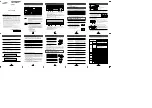
6.6.1 Error Detection
The autochanger error detection methods are extensive. Both processes and
sensors detect errors.
Each of the processes that detect errors are interrelated. Depending on the error
condition, the autochanger expects feedback from one or more of the following
processes before a diagnosis is made:
•
Overforce shutdown
•
Sense of touch
•
Motor position
An overforce shutdown occurs when the motors exert more force than is expected
or required. If this occurs, the servo automatically shuts itself down to prevent
parts damage. After an overforce shutdown occurs, the autochanger analyzes the
situation, self-calibrates, and attempts a retry.
Sense of touch is the process where actual force used is compared to the
recommended force for each move. The autochanger uses this information
to detect errors or qualify moves. The difference between sense of touch and
overforce shutdown is that the servo is not automatically shut down if sense of
touch detects an error.
The positions of the motors are continuously monitored by the controller PCA.
The position, along with the sense of touch feedback, is a valuable source of error
detection.
These processes also combine to detect errors. For example, the sense of touch
and the motor position processes continuously monitor the motor position and
motor force levels to sense whether a potential error has occurred. It does not
imply a sensing of complete force profiles, but the ability to continuously sample
the force profile.
The physical parts of the error detection system are the sensors. These hard-
wired sensors provide information that is impossible to determine through other
means. This feedback information is fed to the autochanger controller PCA.
There are two forms of sensors:
•
Drive handshake - the drive provides a ‘‘BUSY’’ signal back to the
autochanger controller to indicate the status of certain loader operations.
•
Optical sensors - detect conditions that are otherwise difficult to detect and
are used to calibrate the unit. There are two mailslot sensors to detect if a
cartridge is properly inserted into the mailslot, and a sensor for detecting
Theory of Operation 6–23
Summary of Contents for RW504-ZA
Page 10: ......
Page 42: ......
Page 58: ......
Page 106: ......
Page 145: ...Figure 5 22 Optical Disk Library Exploded View Sheet 1 of 3 Removal and Replacement 5 39 ...
Page 146: ...Figure 5 23 Optical Disk Library Exploded View Sheet 2 of 3 5 40 Removal and Replacement ...
Page 147: ...Figure 5 24 Optical Disk Library Exploded View Sheet 3 of 3 Removal and Replacement 5 41 ...
Page 148: ......
Page 206: ......
Page 210: ......
Page 219: ...Voltage Configuration 2 10 Index 5 ...
Page 220: ......
















































